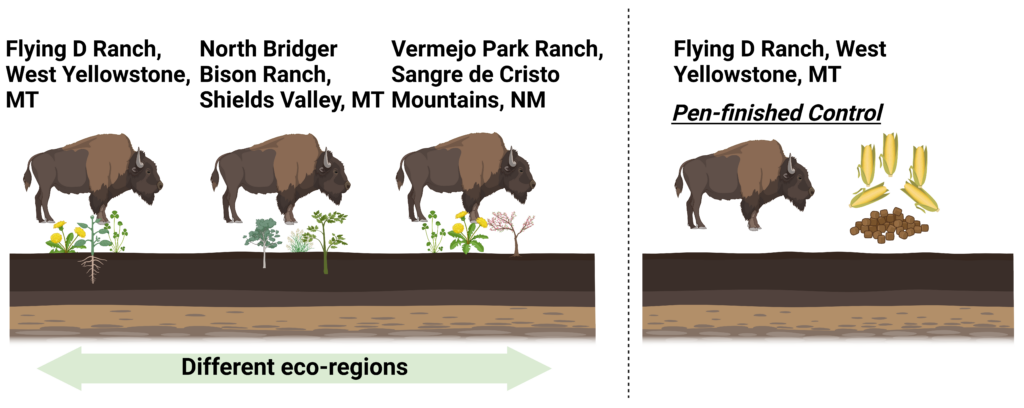Project Overview
Commodities
- Animal Products: meat
Practices
- Animal Production: grazing - rotational, rangeland/pasture management
- Production Systems: agroecosystems
Proposal abstract:
With rising concerns regarding the effects of red meat production on human and environmental health, a growing number of producers are exploring ways to improve livestock production methods. Studies highlight ecosystem benefits of bison's rotational grazing, but the nutritional impact on meat remains unclear. As the adoption of more sustainable ranching practices is ultimately dependent on consumers' interest in healthy products, having information on the impact of different finishing practices is crucial.
The goal of this project is to study the impact of finishing practices (grass and grain) and “terroir” (geographical location) on the nutritional composition of bison meat. We will collect forage/feed and meat samples from three Western bison ranches (two in MT and one in NM) that are using rotational grazing practices. Meat samples will be profiled for nutritional composition using metabolomics approaches and compared to grain-finished bison from an MT ranch as a control. Our focus is on grass-finishing of bison on polyculture pastures, a method that promises multiple ecosystem benefits but is currently underutilized in the industry. We hypothesize that rotationally grazing and finishing bison on polyculture pastures in Western Rangelands will improve the nutritional composition of bison meat, including fatty acid, vitamin/minerals, and phytochemical profile.
With the bison industry's revenue surpassing $340 million and having expected continued yearly growth, the project's goal is timely. We will disseminate our research through national association meetings and field demonstrations to bison farmers, aiming to convert scientific research into practical, actionable, and sustainable farming practices.
Project objectives from proposal:
Fig.1. Graphical abstract of the proposed study.
To achieve the project goal, outlined above in the summary, we will pursue the following specific objectives:
Objective 1: Assess the differences in metabolomic profiles of forage, including the range and concentration of phytochemicals, vitamins, fatty acids and minerals, consumed by bison in pasture-finished systems compared to those in a standard grain-based pen-finished system.
Hypothesis: The forage consumed by pasture-finished bison will display a more complex metabolomic profile with higher levels of phytochemicals, vitamins, omega-3 fatty acids and minerals than the forage from a grain-based pen-finished system.
Objective 2: Quantitatively assess the concentrations of phytochemicals, vitamins, fatty acids and minerals in meat from grass-fed bison across four regional systems, in comparison to those in meat from a pen-finished bison system, utilizing advanced analytical techniques.
Hypothesis: Dietary variation will result in grass-fed bison having superior mineral, vitamin, fatty acid and phytochemical profiles compared to pen-finished bison
Objective 3: Investigate the impact of ecoregion-specific factors ('terroir') on the nutritional composition and phytochemical diversity in pasture-finished bison meat from distinct ranch locations, including Vermejo Park Ranch, Sangre de Cristo Mountains, NM; Flying D Ranch, West Yellowstone, MT; and North Bridger Bison Ranch, Shields Valley, MT.
Hypothesis: Bison meat from different ecoregions will display distinct nutritional and phytochemical profiles, influenced by the unique terroir of each ranch location.
The primary expected outcome of this research project is that the phytochemical, vitamin, mineral, and fatty acid profile of bison meat is significantly influenced by the finishing system and the geographic location of finishing. Simultaneously, this knowledge will pave the way for the development of strategic marketing approaches tailored to bison meat products, particularly those that have undergone grass-finishing. Although this project is centered in Western states, its applicability extends far beyond geographical boundaries and holds the potential for scalability throughout the entire North Central Region/Mid-West Region where bison ranching is common.
Our work will provide an initial critical—and as of yet unstudied—link between finishing practices and location (“terroir” ) on the nutrient density of bison meat. Without knowledge on how grazing practices impacts the healthfulness of bison meat(1), incentives that promote good land stewardship will not reach full potential, as efforts towards making livestock production more sustainable is ultimately dependent on consumer demand for a healthful product. Similarly, we anticipate that gaining more knowledge on how different ecoregions (“terroir”) impact the nutritional quality of bison meat, will help local producers with marketing their products to consumers.
Educational objectives:
- Publish research findings in academic journals detailing the comparative phytochemical richness of bison meat from grass-finished and grain-finished groups.
- Develop an updated and more comprehensive nutritional profile of bison meat influenced by finishing systems, which will be shared with producers through the National Bison Assocation and Turner Ranches Summer Meeting.
- Organize field days with the participating ranchers to facilitate peer-to-peer knowledge to enable ranchers to select finishing systems that yield the most optimally nutrient-dense bison meat products for human consumption.
- Equip ranchers with newfound knowledge to market bison meat based on its nutrient density and the chosen finishing system, thereby meeting the evolving demands of consumers seeking high-quality, health-conscious food choices.
